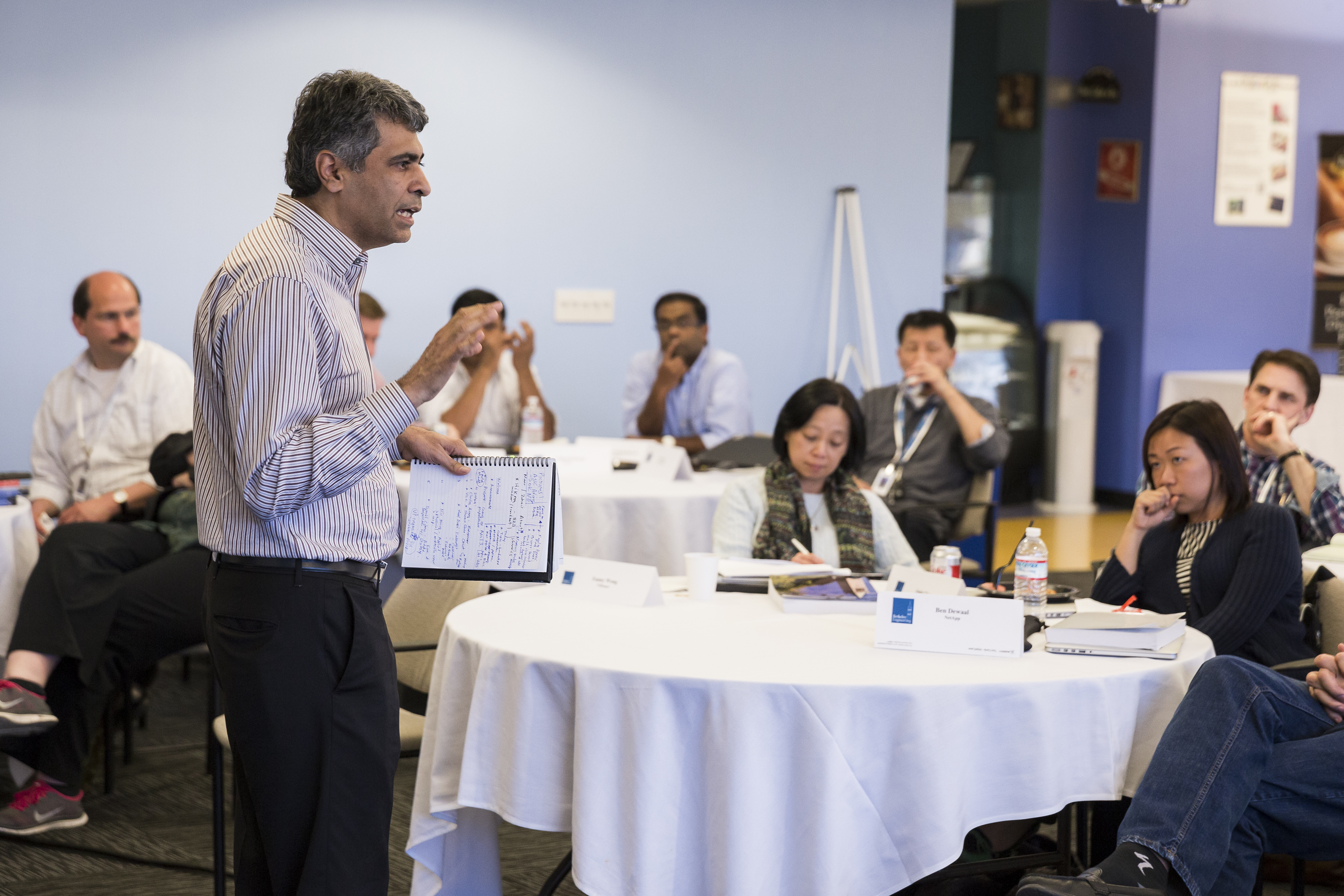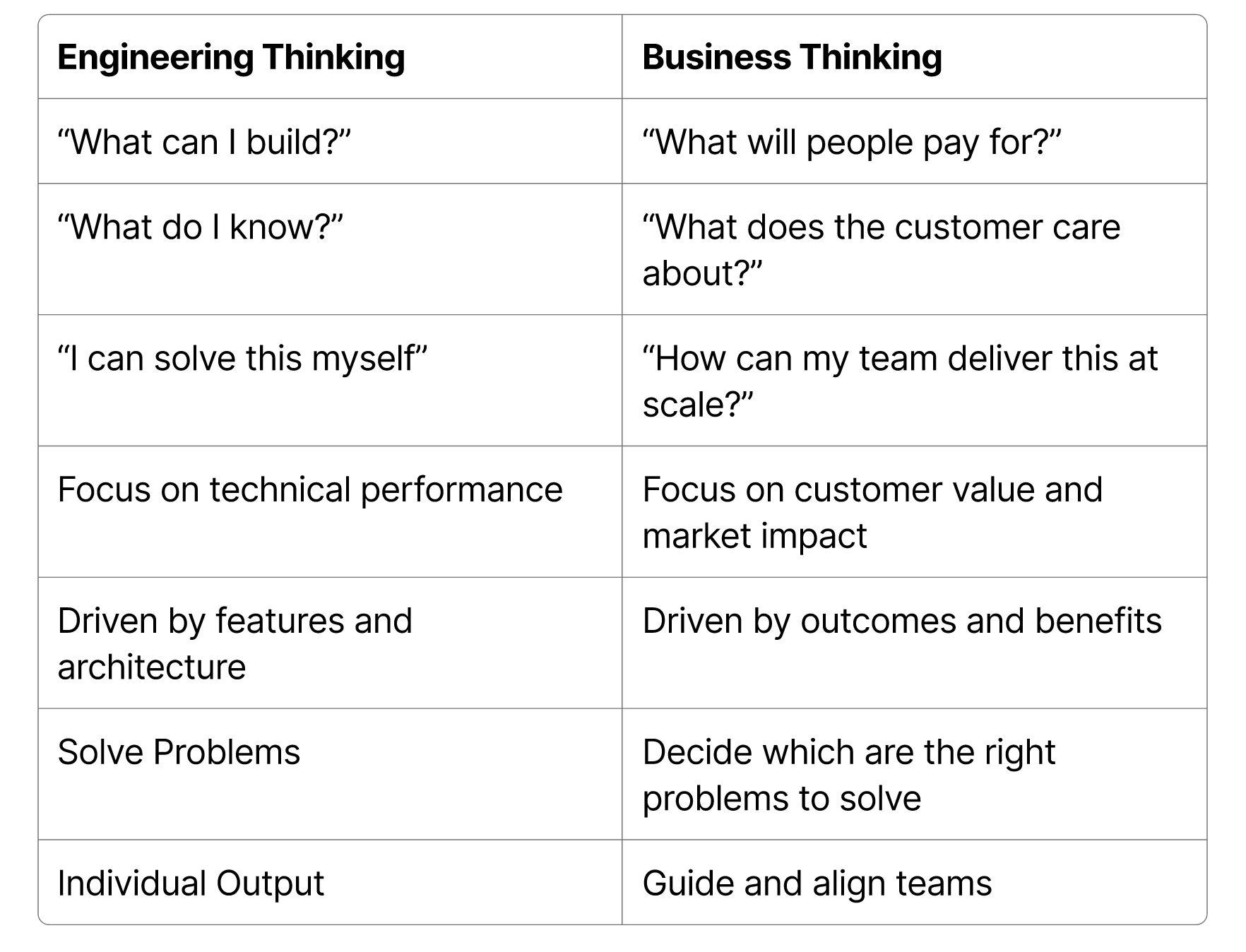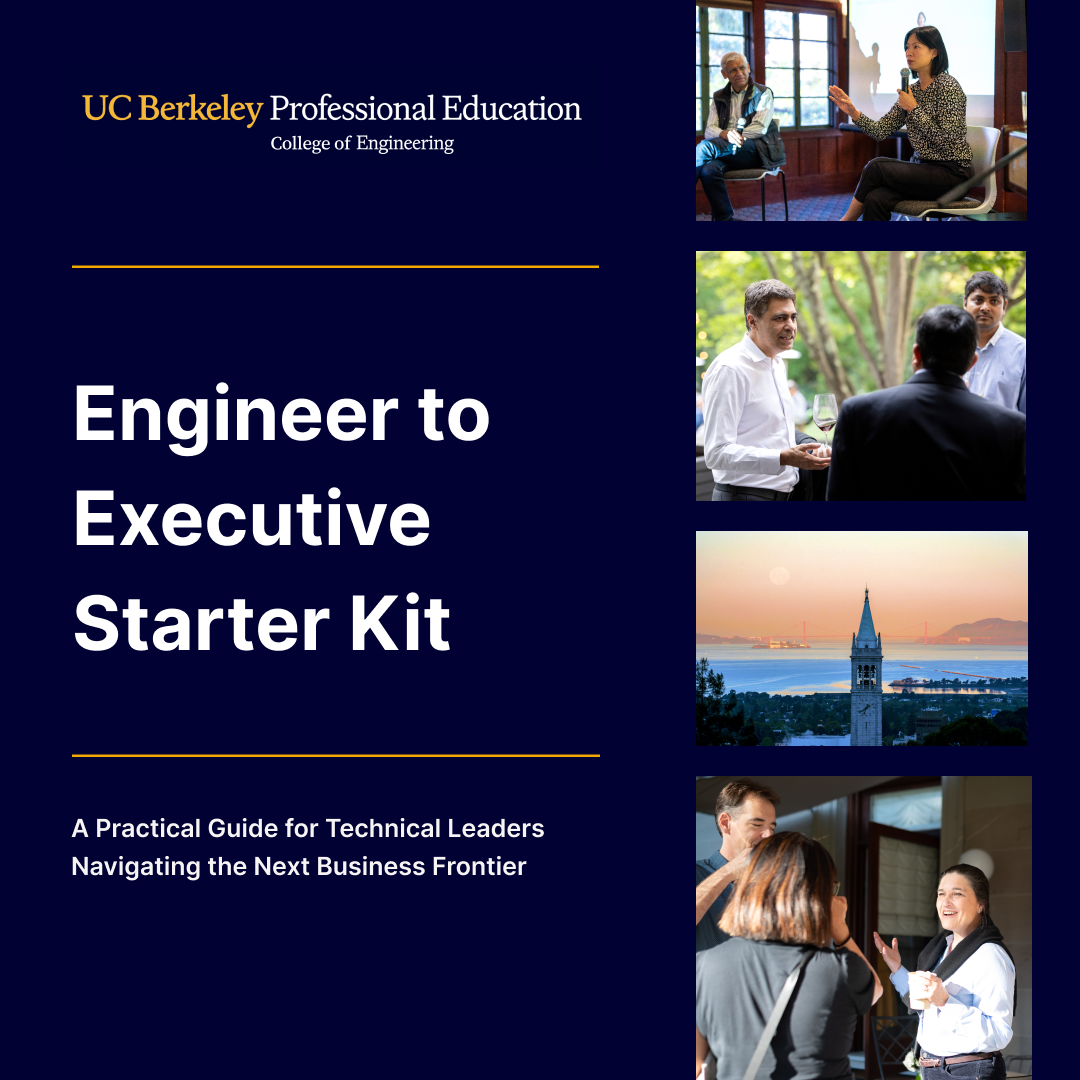Engineer to Executive Starter Kit
A Practical Guide for Technical Leaders Navigating the Next Business Frontier
Preface: A Note to the Engineer
Engineering in the modern world is constantly evolving in the new era of technology and AI. It’s no longer just about building systems, but understanding the systems of business and people that those technologies serve.
If you’re:
- A senior engineer, technical manager, or technology executive ready for what lies beyond the code
- Feeling limited by your current technical role and looking for opportunities to lead bigger initiatives
- Recognizing how AI, automation, and rapid disruption are reshaping your industry, and you’re not sure where you fit in
- Looking to ensure you stay professionally relevant and gain the skills to lead and influence in the long-term
Then this guide is for you.

Why Business?
In a world driven by AI, global markets, and rapid product cycles, engineering excellence alone is no longer sufficient. Engineers who are able to combine their technical expertise with business thinking will have an edge.

The Agentic AI Revolution and What It Means for Executives
Agentic AI is the “Next Big Thing.” Like generative AI, agentic AI builds on large language models (LLMs), but rather than simply creating content, agentic AI systems are composed of autonomous “agents” that are able to perceive environments, reason independently, take “agentic” action towards goals, learn from results, and collaborate with other agents or humans.
Agentic AI is able to actively solve problems. Rather than simply passive tools, they function more like independent collaborators. This means it will shift how complex work is conceived, delegated, and executed.
Many professionals still equate AI with chatbots or image generators: narrow, single-task systems with limited application. This mindset is outdated.
Just as the internal combustion engine wasn’t just for lawnmowers but also enabled cars, airplanes, ships, and rockets, agentic AI is now reshaping industries, redefining business models, and enabling value chains.
Agentic AI as these systems are more efficient, scalable, and often more economical than human-driven workflows for repetitive or complex coordination tasks. This matters for leadership because the organizations that successfully integrate agentic AI will be more efficient, adaptive, and strategically flexible. These systems will change how companies think about teams, project management, strategy, value, and workflows.
Engineers with a solid grasp of these foundations will be better positioned to lead in the AI age. The ability to design and direct autonomous agents and AI operations will be a key leadership differentiator.
Leaders who mistake agentic AI for “just another tool” will find themselves outpaced by competitors who see its strategic value. Engineers who treat AI literacy as optional will risk irrelevance in boardrooms where broader business decisions and strategy increasingly consider AI as a factor.
To lead effectively, engineers need fluency not only in the technical domains of AI, but also how such agentic systems align with real-world business objectives and challenges.
Engineering Leadership (ELPP) – Global Online
Online · Starts Aug 20 · Registration ends Aug 1
Broaden your leadership horizon in under 5 months

Core Skills for Engineers Moving into Business Leadership
As the technology landscape evolves, success won’t be determined solely by technical ability, but the cultivation of a broader set of adaptive, human, and strategic skills.
1. Curiosity
Curiosity is the fuel for career longevity.
Curiosity
- Pushes you beyond your current knowledge base and skill set
- Encourages you to connect seemingly unrelated ideas
- Helps you stay employable in an era where knowledge is constantly evolving
The information is out there. The barriers to learning have never been lower. However, engineers who stop being curious fall behind quickly. The moment engineers stop asking “What else is out there?” or “Why does this matter?”, they risk becoming professionally obsolete.
Shomit Ghose, partner at Clearvision Ventures, explains “Everyone should have two jobs.”
Job #1: The job you get paid for.
Job #2: The job of curiosity. This one doesn’t pay you, but it keeps you employable.
2. Marketing
Marketing acts as a bridge between product and people.
Ikhlaq Sidhu, founding director of SCET, emphasizes the significance of connecting deep technical knowledge with real-world industry application. “There’s some very abstract topics that people learn in technical fields, and when you spend all your time learning these abstract things, you don’t always know how to connect it to the things that are happening everyday or in the workplace.”
 Ikhlaq Sidhu, founding director of SCET, presenting at ELPP
Ikhlaq Sidhu, founding director of SCET, presenting at ELPP
Marketing is often misunderstood as “just advertising.” In reality, marketing is the business of understanding people: what they want, what they value, and how they make decisions.
For engineers transitioning into business, marketing provides a shift in perspective from technical features to the benefits and values to the customer.
Understanding marketing frameworks helps you:
- Define product-market fit
- Communicate value in customer language
- Influence company direction
3. Communication
Aravind Srinivas, CEO of Perplexity, advises in the Newton Lecture Series:
“The most successful professionals are those who are able to communicate their thoughts very well, whether it’s to other humans or to an AI.”
 Spring25 Richard Newton Series Lecture X Perplexity CEO & Founder Aravind Srinivas with his former PhD advisor, Pieter Abbeel
Spring25 Richard Newton Series Lecture X Perplexity CEO & Founder Aravind Srinivas with his former PhD advisor, Pieter Abbeel

Perplexity CEO & Founder Aravind Srinivas meets with students from Spring25 Richard Newton Series to take questions and explore ideas
As an engineer, communication may have been centered on precision and peer-to-peer dialogue. However, as a business leader, communication shifts.
The audience is no longer limited to fellow technologists, but also expands to include customers, executives, investors, and other teams. Rather than hearing how it works, they want to know why it matters.
Great business leaders:
- Translate technical complexity into business value
- Distill a complex solution into a simple, compelling narrative
- Adjust their messaging based on the audience
This clarity becomes more valuable than technical precision.
Communication spans:
- Interpersonal dialogue (1:1s, feedback, alignment, negotiation, brainstorming)
- Public speaking (internal all-hands, external conferences)
- Written communication (emails, proposals, strategy documents)
As the coding capabilities of AI continue to advance, the role of engineering leaders evolves to include the ability to frame problems, propose solutions, and persuade others to act.
To be a strong communicator, you don’t need to be a natural speaker, but a practiced one.
Build your communication muscle by:
- Sharpening clarity and adaptability by explaining your work to non-technical peers or different age groups.
- Developing public speaking skills and confidence by presenting at small group discussions, internal meetings, or at conferences.
- Strengthen your writing through memos, project updates, or planning documents to align teams and influence decisions.
4. Cultural Intelligence
As engineers move into management and leadership roles, they will increasingly encounter cross-cultural dynamics, whether within internal teams or international partnerships. Innovation ecosystems thrive around the world, from mature markets such as China and Japan (which face both opportunities and challenges) to high-growth regions like Indonesia.
To lead in cross-cultural contexts, engineers must develop cultural intelligence, which includes:
- Developing cultural sensitivity through understanding and respecting differences in user behavior, work styles, and communication norms
- Building cultural adaptability through learning to fit local regulatory environments, business practices, and market dynamics
- Staying informed about emerging technologies, market trends, and how users across the world interact with digital products and services
Transition from technical
experts to strategic leaders
Key Mindset Shifts from Engineer to Business Leader
The transition from engineering to business leadership requires a different operating system. This starts with asking different questions.

As an engineer, it’s natural to measure success by performance: how fast, how elegant, how efficient.
However, as a business leader, success is measured by value delivered:
- Does it solve a real customer problem?
- Will they pay for it?
- Does it move a meaningful business metric?
- Is this the right problem to prioritize right now?
Looking beyond “What’s possible?”, the next question is “What’s valuable?”
This requires understanding:
- Customers’ pain points
- What drives their decisions
- The cost of their problem (financially, emotionally, operationally)
Technical perfection often comes at a cost, whether it’s time, complexity, scalability. A leader’s job is to balance technical excellence with business constraints. There needs to be a clear focus to ensure that decisions are steering efforts in the right direction.
![]() Silicon Valley Innovation Leadership (SVIL) Final Deliverables Dinner
Silicon Valley Innovation Leadership (SVIL) Final Deliverables Dinner
Wondering how to accelerate your leadership growth? Join today at ELPP to practice skills in finance, influence, communication, and innovation management.
Engineering Leadership (ELPP) – Global Online
Online · Starts Aug 20 · Registration ends Aug 1
Broaden your leadership horizon in under 5 months
The Real Challenge Isn’t Technology; It’s People
For engineers stepping into executive or leadership roles, the biggest adjustment isn't technical; it’s human. While engineering problems often have defined inputs and logical solutions, people are variable, emotional, and unpredictable.
Scaling from an individual contributor to a leader means handling two primary people challenges:
1. Your Team
As an engineer, you’re responsible for your own performance. You’re a sole practitioner, and you only have to worry about your work. However, as a leader, success depends on what the team achieves collectively. This shifts your job from executing to enabling.
Your role becomes to:
- Align diverse personalities and capabilities
- Motivate across different working styles
- Resolve friction and prioritize team health
- Coach rather than correct
Strategies for healthy team communication include:
- Make it clear from the beginning that sharing ideas, suggestions, and feedback is welcome and encouraged
- Offer constructive feedback that incorporates both strengths and areas for improvement
- Minimize miscommunications through active listening and asking clarifying questions to ensure clear, mutual understanding
- Strengthen team relationships through consistent, respectful, and open communication
- Maintain transparency by communicating updates and changes clearly and promptly
- Address concerns when they appear to prevent them from escalating or leading to further miscommunication
- Pay attention to nonverbal communication (e.g. facial expressions, body language, eye contact, tone of voice, handshakes, posture, virtual meeting etiquette, wardrobe choice)
- Scheduling 1:1 check-in meetings to allow space for personal conversations and feedback
Each team member has different communication styles, values, and motivations. The ability to connect, inspire, and guide teams will determine the quality and speed of the team’s outcomes.
2. Your Customers
Customers are often less concerned with the technical architecture. They care more about what your product does for them.
- Does this product save me time?
- Will it reduce my costs?
- Can it help me hit my targets?
Your role is to:
- Translate features into benefits
- Speak their language
- Align your offering with their pain points
- Guide them to recognize your value
Rather than selling technology, the goal is to solve a problem and show them why it’s worth more than the money they’re spending.
This is often the hardest shift for engineers to make: you’re no longer in full control. You can’t write all the code, solve every issue, or predict every outcome. You now operate in a world of people, priorities, and trade-offs. Execution becomes a team effort, and progress depends on the alignment, motivation, and communication of multiple individuals.
Customer communications is about building relationships at every touchpoint in the customer journey. Every interaction a customer has with the brand shapes their experience and perception of the brand, which in turn influences their decision to remain loyal.
In practice, strategies for effective customer communication include:
- Understanding the priorities and needs of your different audience groups
- Providing omnichannel experiences means engaging with customers where they are (e.g. email, phone, social media, in-person experiences)
- Earning trust over time by consistently delivering value, not just during the sale but throughout the entire journey
- Personalizing the customer experience through highly tailored recommendations that feel thoughtful and relevant
- Crafting a brand voice that reflects the relationship you want to build (e.g. using emojis, humor, and conversational language for a warm, approachable voice vs using numbers, sophisticated design elements, and formal language to convey trust and authority)
- Proactively inviting (e.g. surveys, interviews, social listening) and addressing feedback
The biggest investment to make is not in more technical knowledge, but becoming better at understanding, aligning, and empowering the people around you.
 Panel at SCET discussing blockchain
Panel at SCET discussing blockchain
Ready to lead your company
through change?
Common Misconceptions to Debug
As engineers transition into leadership roles, several mindset traps can hold them back.
1. ❌ “It’s about the technology.”
While the product may be innovative, it needs to serve a business need or drive a path to profitability.
Every business exists to create value. That means:
- Understanding where money flows
- Recognizing what customers are willing to pay for
- Identifying the priorities of business stakeholders (e.g. revenue, cost, risk level and mitigation, return on investment, sales)
- Building solutions that align with all the above needs
Engineering decisions need business context.
2. ❌ “We just need a better product.”
A better product isn’t always enough. In fact, many technically superior products fail because they were not clearly communicated.
A great product must be:
- Perceived as valuable
- Understood by its intended user
- Positioned in a way that makes the benefits clear
It’s not always about adding more features and functionality, but framing the value in a way that is easily understood by the customer.
3. ❌ “I’ll stay in my lane.”
The best leaders break silos and see the full picture.
Many engineers are taught to go deep, specialize, and stay in their domain. However, business leadership requires going broad.
Step outside your comfort zone and learn about the work and goals of other departments. Figure out how each team in the organization fits together.
When you understand the broader system, you’re able to:
- Spot inefficiencies others miss
- Build better cross-functional alignment
- Create solutions that not only support your departments’ goals, but the company’s mission
4. ❌ “More authority means more control.”
While this may be true, it’s not without caveats. Promotions often bring more constraints as it means balancing various stakeholder interests, limited resources, and long-term vision. The role becomes less about control and more about coordination.
Higher level roles are often about aligning diverse priorities, making decisions under pressure, and navigating complexity with a big-picture perspective.
 A team of 2023 ELPP students receiving feedback on their presentation
A team of 2023 ELPP students receiving feedback on their presentation
Ready to lead your company
through change?
Amplifying the Engineer’s Advantage
The technical background of an engineer is a strong advantage when leveraged correctly in business and leadership contexts.
An engineering mindset equips you with:
- Product intuition to assess technical feasibility and make informed product decisions
- Analytical rigor to evaluate trade-offs
- Technical credibility to gain trust from customers, investors, and stakeholders
However, technical depth alone isn't enough. Many engineers fall into the trap of overexplaining or diving too deeply into technical details. The reality is that most customers, executives, and investors care more about how it solves their specific problem.
Shomit Ghose suggests communicating through this formula: “It sounds like your problem is X. Our solution is Y, and it works by doing Z.”
1. Simplify
Avoid jargon, use analogies, and break down complex systems into high-level frameworks or clear value propositions.
2. Focus on Concepts, Not Mechanics
People grasp concepts. If they’re not the ones executing the technical details, it often is not necessary.
3. Tell Stories
Remember: “Data tell. Stories sell.”
Frame technology in terms of real-world outcomes. Once understanding the customer’s problem, humanize the pitch in a story that connects with them in a way that they understand how the product or service fits into their lives.
 2023 ELPP student discussing with Berkeley Method of Entrepreneurship (BMOE) Bootcamp Chair, Gigi Wang
2023 ELPP student discussing with Berkeley Method of Entrepreneurship (BMOE) Bootcamp Chair, Gigi Wang
Building Executive Muscle
Becoming a strong engineering leader in today’s world requires more than technical expertise. The real leap happens when engineers build executive muscle: the strategic mindset, decision-making ability, and people insight needed to drive organizations forward.
So what does that look like in practice?
1. Ask Better Questions
Today’s leaders think beyond the code. Rather than responding to trends, they seek to understand their causes and implications. Whenever a new technology or business phenomenon emerges, pause to ask:
- How does this actually work?
- Why is this gaining traction now?
- Who benefits from this and how?
- Is this a short-lived trend or a fundamental shift?
Action Step: Identify three emerging technologies or fields that excite you, read about the latest news and developments, and explore how each one can impact your industry, business model, or customer needs. Developing a habit of staying informed about broader trends and how they are relevant to your industry and the people in it helps you build long-term vision, credibility, and strategic foresight.
2. Learn Behavioral Economics
Business isn’t just built on systems, but people. People's behavior is predictably irrational, and learning behavioral economics, an “entrepreneur’s best friend,” helps to build an understanding in how people make decisions.
For example, Netflix doesn’t provide 1,000 titles. It shows you “Top 10 Today.” This behavioral design curates choices to influence action.
3. Master Numbers and Data Literacy
Executive decisions need to be grounded in reality. Numbers tell the story, but not all data is equally valuable.
You need to understand:
- Which metrics matter (e.g. retention rate vs. vanity metrics like downloads)
- How to use data hierarchies to guide prediction and prioritization
- How AI and analytics tools work
4. Sharpen Decision-Making Clarity
One of the biggest differences between engineers and executives is how they make decisions under uncertainty.
Engineers are often trained to seek precision. However, as a business leader, you often won’t be able to make decisions with the full story or information. Instead, you’ll need to
- Make high impact decisions with incomplete data
- Prioritize ruthlessly
- Let go of low-value work, even if it’s technically interesting
- Strengthen your ability to think big picture and long term
Good decision-making is not about having perfect data, but knowing what truly matters. Strong leaders can distinguish between signal and noise, and they’re comfortable acting even without 100% certainty.
5. Adopt a Systems Mindset
Engineering teaches you to understand how different pieces fit together in code. Leadership demands the same, but for people, departments, goals, and incentives.
Don’t pigeonhole yourself into your specialty. Don’t wait for someone else to connect the dots. Venture outside your comfort zone. Look up, look across, and find patterns and opportunities that emerge when you expand your vision and view.
 ELPP Graduation
ELPP Graduation
Conclusion: The Next Generation of Engineering Leaders
The future of engineering leadership will not be led by pure technologists who can only write the best code or architect the cleanest system. Rather, leaders at the forefront of technological waves will be those who can also think like strategists, speak like executives, and act like entrepreneurs.
The next generation of engineering leaders are
- Technologists who understand markets, business models, and human behavior
- Strategically curious and always asking “why does this matter?” and “what else is possible?”
- People-centric, realizing leadership is about connecting, inspiring, and empowering teams
- Decision-makers who use their technical foundations to drive faster, smarter, and more profitable outcomes
If this sounds like your journey, you’re in the right place.
 2023 ELPP students
2023 ELPP students
Engineering Leadership (ELPP) – Global Online
Online · Starts Aug 20 · Registration ends Aug 1
Broaden your leadership horizon in under 5 months
Why ELPP Is Your Next Step
The Engineering Leadership Professional Program (ELPP) was built to accelerate this transformation from engineering to upper level business management. It’s a curated, high-impact bridge between engineering excellence and business acumen. Through real-world case studies, interactive discussions, and group projects, you’ll learn directly from industry pioneers including founders, venture capitalists, and C-level executives from companies like Netflix, DeepMind, Siri, and Cisco.
ELPP is your strategic advantage that positions you ahead of the competition.
In 5 months, you’ll push the boundaries of what you know and get exposure to the critical dimensions of executive thinking and leadership including:
- Product Marketing
- Financial Accounting
- Influence and Negotiations
- Leadership and Communication
- Decision-Making Frameworks
By the end of the program, you’ll be positioned to:
- Evaluate technology shifts and emerging trends with a critical business lens
- Contribute meaningfully to executive-level discussions about profitability, growth, strategy, and broader business operations
- Future-proof your skill set through long-term, relevant business fluency
- Break out of technical silos and see how different functions (e.g. marketing, sales, finance) contribute to the overall company success
- Master communication and negotiation strategies to influence executives, customers, and cross-functional peers
- Build a strategic network of experienced engineers, managers, future executives, VCs, founders, C-suite leaders
ELPP is a tasting menu for modern innovation, designed specifically for engineers.
More importantly, ELPP helps you avoid a common professional trap of being a technical expert stuck in a narrow lane. When markets shift or technology evolves, siloed expertise becomes a professional risk.
If you’re ready to grow beyond your current role, think bigger, and lead, ELPP is your launchpad.
Are you ready to lead? Join more than 1,000 professionals who have taken the next step in their career with ELPP.
This article was written by Wendy Zeng, with guidance from Keith Joseph McAleer, in-depth insights from Shomit Ghose, additional perspective from Andrew Yu, and publishing support from Rachel Zhang.
Join today to maximize your
leadership potential

